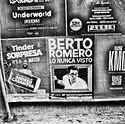This is coincidentally timely. I was doing some testing on some new-to-me cameras over the last few days, and ran into the backing paper issues in a big way.
I was using old film, since I just wanted to test for light leaks and other mechanical/optical issues. I had an old roll of Pan F Plus from the 90's (I think), that I used in a Yashica Mat, and some old 35mm bulk rolled Pan F from the mid 80's for two old 35mm cameras.
I processed all the film together in one tank, since it was all Pan F.
After the film dried, I held the negatives up to the light for a cursory inspection. The 120 roll of Pan F Plus showed severe mottling that got progressively worse through the roll. The rebate area had lots of easily visible spots near the end of the roll. The 35mm film all turned out nicely with no obvious problems, so there wasn't a developing issue.
I've had problems with old 120 film with the backing paper causing damage to the negatives, but never anything near this bad. I scanned them anyway, since this roll was for camera testing rather than film testing. I was really surprised when I scanned two shots near the middle of the roll. I could clearly see that the dots and numbers from the backing paper had transferred to the negatives. I still had the backing paper and the original packaging sleeve for that roll, so I took some pictures of it.
I've never seen numbering and dots from the backing paper being transferred to the negatives, but here's the proof. In the first shot you can also see the comparison of the old Pan F Plus backing paper compared to some newer Ilford backing paper. The old stuff is going to be easier to see under the red window in a camera, but it obviously isn't good for long term storage with the film.
This particular roll of Pan F Plus was not ever refrigerated or frozen, as far as I'm aware, so it was a throw-away item anyway. I guess the lesson learned from this is that the film itself will last a long time (as in 35mm), but the backing paper will limit the useful life of 120.















